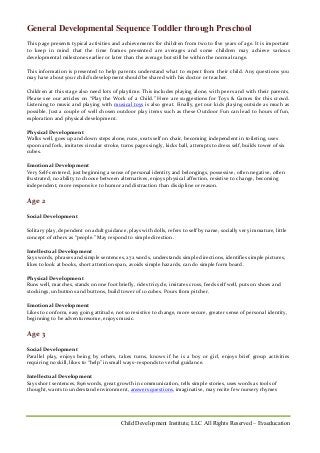
general_developmental_sequence_toddler_through_preschool.pdf
- 1. Child Development Institute, LLC All Rights Reserved – Evaeducation General Developmental Sequence Toddler through Preschool This page presents typical activities and achievements for children from two to five years of age. It is important to keep in mind that the time frames presented are averages and some children may achieve various developmental milestones earlier or later than the average but still be within the normal range. This information is presented to help parents understand what to expect from their child. Any questions you may have about your child’s development should be shared with his doctor or teacher. Children at this stage also need lots of playtime. This includes playing alone, with peers and with their parents. Please see our articles on “Play the Work of a Child.” Here are suggestions for Toys & Games for this crowd. Listening to music and playing with musical toys is also great. Finally, get our kids playing outside as much as possible. Just a couple of well chosen outdoor play items such as these Outdoor Fun can lead to hours of fun, exploration and physical development. Physical Development Walks well, goes up and down steps alone, runs, seats self on chair, becoming independent in toileting, uses spoon and fork, imitates circular stroke, turns pages singly, kicks ball, attempts to dress self, builds tower of six cubes. Emotional Development Very Self-centered, just beginning a sense of personal identity and belongings, possessive, often negative, often frustrated, no ability to choose between alternatives, enjoys physical affection, resistive to change, becoming independent, more responsive to humor and distraction than discipline or reason. Age 2 Social Development Solitary play, dependent on adult guidance, plays with dolls, refers to self by name, socially very immature, little concept of others as “people.” May respond to simple direction. Intellectual Development Says words, phrases and simple sentences, 272 words, understands simple directions, identifies simple pictures, likes to look at books, short attention span, avoids simple hazards, can do simple form board. Physical Development Runs well, marches, stands on one foot briefly, rides tricycle, imitates cross, feeds self well, puts on shoes and stockings, unbuttons and buttons, build tower of 10 cubes. Pours from pitcher. Emotional Development Likes to conform, easy going attitude, not so resistive to change, more secure, greater sense of personal identity, beginning to be adventuresome, enjoys music. Age 3 Social Development Parallel play, enjoys being by others, takes turns, knows if he is a boy or girl, enjoys brief group activities requiring no skill, likes to “help” in small ways–responds to verbal guidance. Intellectual Development Says short sentences, 896 words, great growth in communication, tells simple stories, uses words as tools of thought, wants to understand environment, answers questions, imaginative, may recite few nursery rhymes
- 2. Child Development Institute, LLC All Rights Reserved – Evaeducation Physical Development Skips on one foot, draws “Man”, cuts with scissors (not well), can wash and dry face, dress self except ties, standing broad jump, throws ball overhand, high motor drive. Emotional Development Seems sure of himself, out-of bounds behavior, often negative, may be defiant, seems to be testing himself out, needs controlled freedom. Age 4 Age 4 Social Development Cooperative play, enjoys other children’s company, highly social, may play loosely organized group games – tag, duck-duck-goose, talkative, versatile. Intellectual Development Uses complete sentences, 1540 words, asks endless questions, learning to generalize, highly imaginative, dramatic, can draw recognizable simple objects. Physical Development Hops and skips, dresses without help, good balance and smoother muscle action, skates, rides wagon and scooter, prints simple letters, handedness established, ties shoes, girls small muscle development about 1 year ahead of boys. Emotional Development Self-assured, stable, well-adjusted, home-centered, likes to associate with mother, capable, of some self- criticism, enjoys responsibility. Likes to follow the rules. Age 5 Social Development Highly cooperative play, has special “friends”, highly organized, enjoys simple table games requiring turns and observing rules, “school”, feels pride clothes and accomplishments, eager to carry out some responsibility. Intellectual Development 2,072 words, tells long tales, carries out direction well, reads own name, counts to 10, asks meaning of words, knows colors, beginning to know difference between fact and fiction-lying, interested in environment, city, stores, etc.
